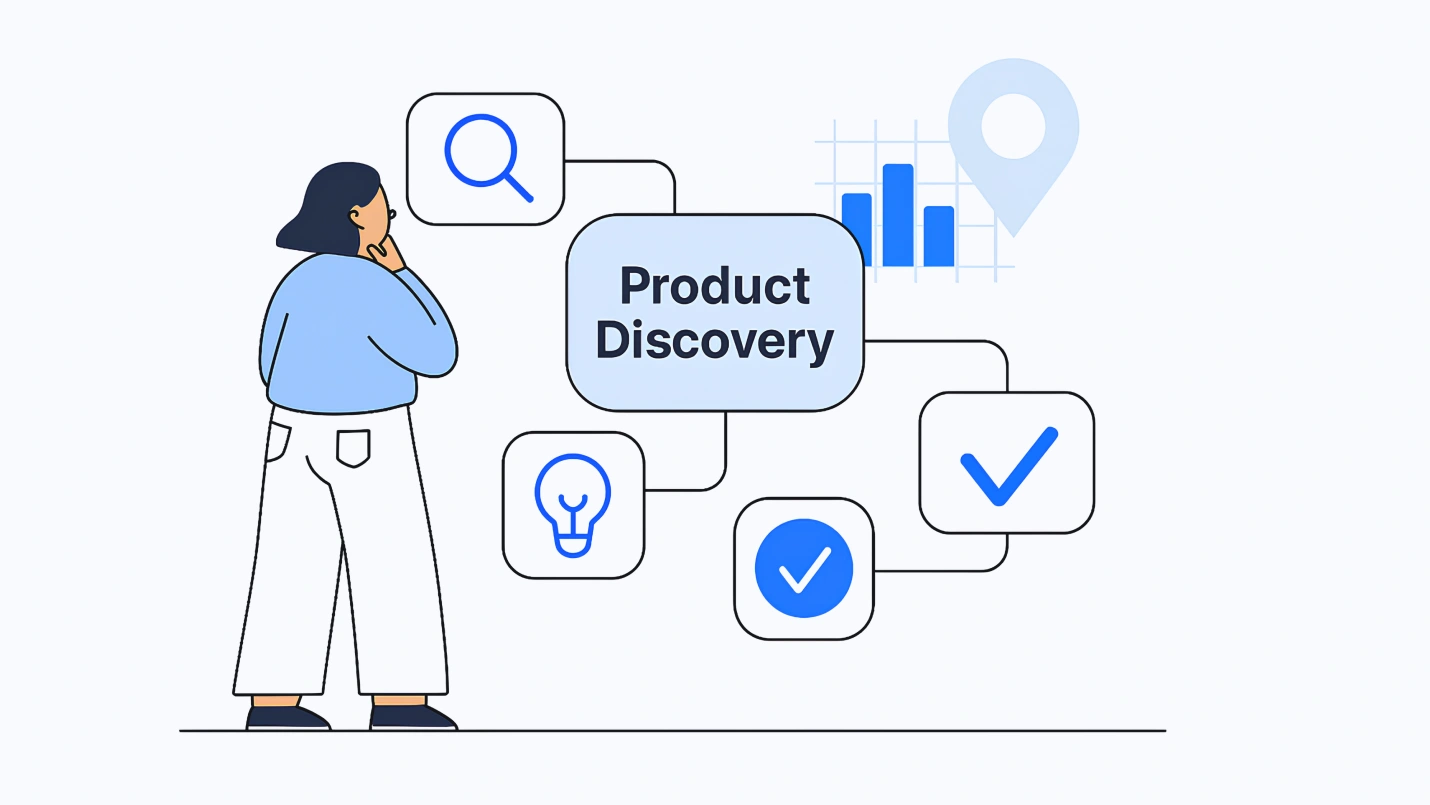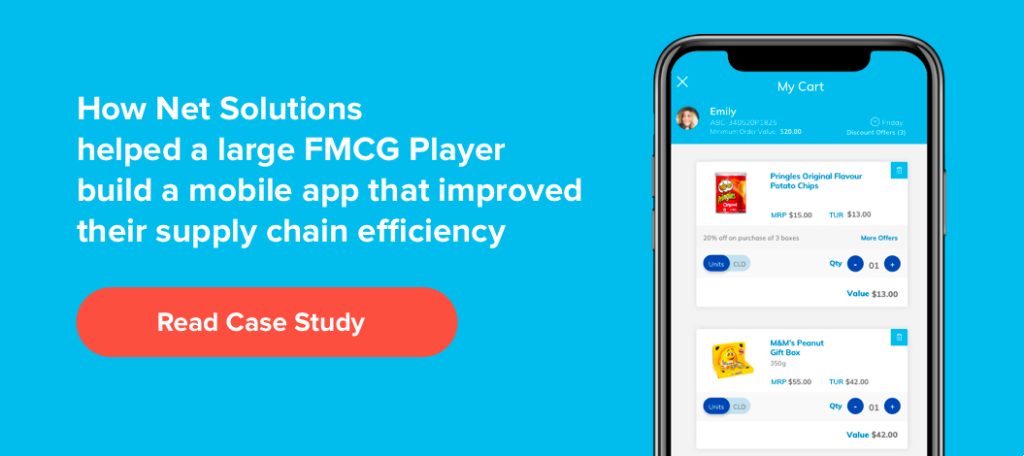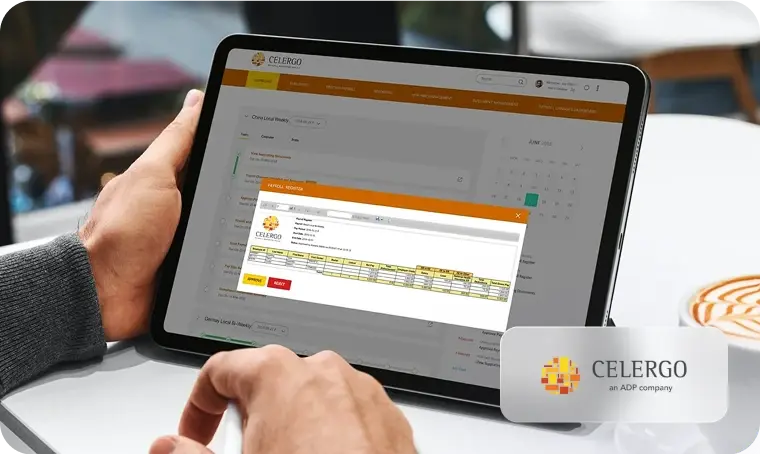Developing a product is not an easy task. No matter what type of product or feature you are planning to build, doing it from scratch requires a lot of research, commitment, time, and money.
Just like Rome wasn’t built in a single day, products would not deliver expected results if made in a hurry or with the wrong approach.
However, product managers often don’t put enough focus in discovering what their users need. As a result, they end up building just “Nice to have features” instead of something that is essential to their customers.
Other times, they start with realistic expectations, but at some point, the process falls apart, priorities get changed, deadlines get missed, or budgets get reallocated.
All this happens because of not understanding the requirements thoroughly and extensively, which can only be done through product discovery.
Here’s a comprehensive guide that will walk you through the product discovery process for building useful and successful products. So, let’s deep dive.
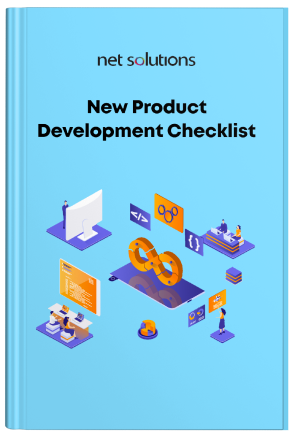
We respect your privacy. Your information is safe.
What is Product Discovery?
Product discovery is unarguably the most challenging yet essential phase of your software development lifecycle. It is all about making sure that you are trying to solve the right problem, for the right group of audience, and at the right time.
While going through the product discovery phase, each day can be an emotional rollercoaster ride for your team, having irritating lows and extreme excitement. At one point, you will fall in love with your idea, the next moment you might hate it.
However, staying user-centric, laser-focused, enthusiastic, and flexible are the keys to successfully completing product discovery that will set the foundation for building the right product.
If we talk about a rough presentation, here is what product discovery Lifecycle looks like:
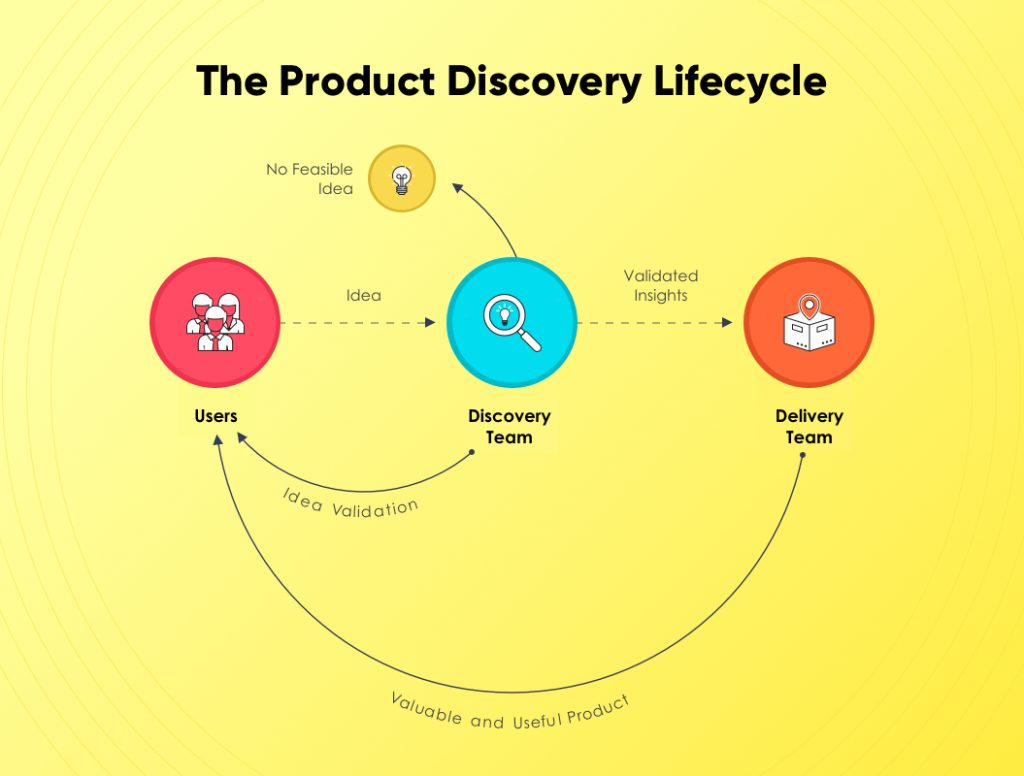
Product development teams either work on the problem space or the solution space. In the product discovery phase, they mostly work on the problem space, aiming to:
- Test assumptions they have around the product idea and see how it will help users solve their problems.
- Find and document the present issues users are facing by interviewing them or conducting surveys.
- Creating different user personas and demonstrating how each one of their users will interact with the product.
- Spending enough time analyzing user problems and understanding them to develop effective solutions.
- Defining core features of the product that will help the customers most in solving their pain points.
- Exploring all types of risks involved in product development — value risk, usability risk, and feasibility risk.
Though product discovery alone won’t guarantee success, it will set the right base for the rest of the product development phases. Therefore, before spending thousands of dollars on development, consider focusing on researching the problem you are trying to solve and how it is going to ease your customer’s lives.
When is Product Discovery Needed?
Product discovery is required when there are unknowns about what the team needs to build, for whom, and why. Developing a product based on assumptions can be risky. You may end up solving a problem that is already cracked – wasting efforts, resources, time, and money.
Below are some of the situations when a discovery is needed:
New Opportunities: If you are looking to expand your business by launching your product or services in a different country or for people with different demographics, discovery is often required. It might involve research around the target audience, competitors, scope of the product, and opportunity size.
New Product Development: If you have an idea of building a new product in your mind, it is better not to start development until discovering the customer segment, their needs, and preferences. Product discovery methodologies focus on the problem space of customers and lets you build exactly what is needed.
Upgrading Products: When you plan to add a new feature to your product, it is crucial to find and analyze what problem it will solve for your users and its impact on the overall product experience.
Acquisitions or Mergers: When companies merge, the systems, processes, and tools also require consolidation. A discovery could focus on mutual problems and find solutions that serve the needs and support operations effectively.
During the product discovery phase, product teams understand user problems. They may likewise have some significant ideas for solutions that they can take forward and test. Sometimes, the discovery phase may decide not to move ahead with the project as there isn’t a user need.
Product Discovery Team Structure
When a project starts, product discovery helps the team choose the right direction, a common goal, and a vision. Therefore, it is crucial to involve all the stakeholders and team members in the process.
While the structure of product discovery teams may vary depending on the project’s complexity and organization size, it usually consists of members playing the following roles:
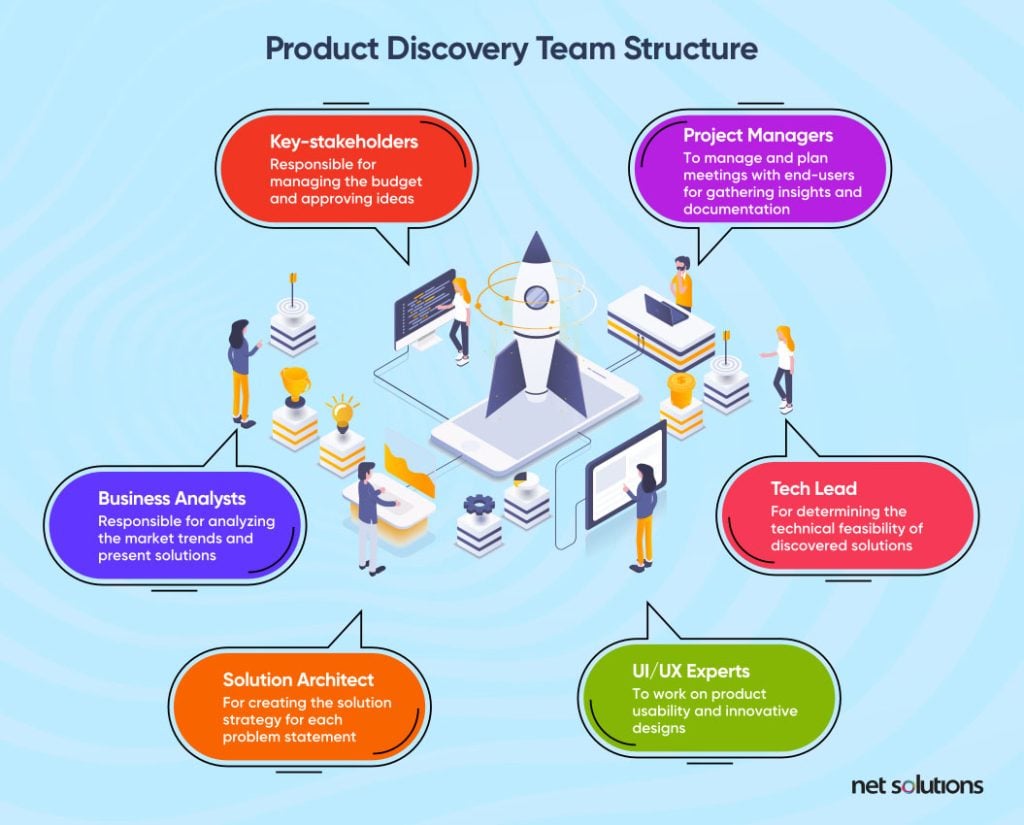
Product discovery is a team effort. The members from all departments, including product, design, and development, have a unique set of ideas and bring a valuable perspective to the table.
So, while working on product discovery, it is better to not limit designers to design, developers to code, and project managers to deal with stakeholders. Let them all come up with whatever they have in their minds and be a part of user problems. This way, you will be able to see product discovery as an actual team effort, and your team will feel connected at every stage of the product development process.
Product Discovery Questions
30,000+ new products are released every year, and 95% of them fail – Harvard Business School professor Clayton Christensen.
Keeping in mind that tech businesses are delicate, there will always be enough competition to stay relevant and useful for the users. Therefore, tech companies strive to iterate their products systematically based on their product discovery processes.
Here are a few questions to not just start but sharpen your product discovery initiative to give it the right shape:
Category 1: The Problem Space
- What is the problem?
- Who are the users facing it?
- How many people are facing it?
- What are the demographics of target users?
- How are they dealing with the problem at present?
- What tools or features your users wish to have?
Category 2: The Solution Space
- What do users dislike about the current solution?
- Who else has already solved the same problem?
- If many, why will users use your product?
- If none, why is it so tough?
- Is it even feasible?
- Why will customers use your product?
- What value will it add to the user’s lives?
Category 3: The Business Space
- What value will the product add to your business?
- Does the product align with your business goals?
- Do we have a roadmap to build this product?
- How can we monetize it?
- Are there any challenges in developing it?
- What will be the KPIs to monitor the success?
- What is going to be the cost of development?
The Outcome of Product Discovery Process
Product discovery isn’t just a process that you need to validate your idea. As a result of product discovery, you will have the following data that will support your web or mobile app development:
- A well-defined problem statement
- User-journey maps
- User-needs statements
- A service blueprint
- User Personas
- Business Value Propositions
- High-level wireframes
Product discovery is the first phase of product development. It may involve different sizes of teams and resources with diverse skill sets depending on the situation. However, all discoveries aim to collect insights about the problem space.
6 Product Discovery Phases for Agile Teams
Just like many things in an Agile environment, product discovery is not a linear process. But, it is good to follow a specific approach to move in the right direction. Here is how a product discovery Process looks like when looking from an holistic perspective:
- Framing a problem
- Finding possible solutions
- Aligning your team
Remember, while doing product discovery, you can always go back to the previous step and take a different route altogether. However, for structuring your ideas and insights, you must segregate the entire process into phases.
The entire Product Delivery Process revolves around the following six phases:
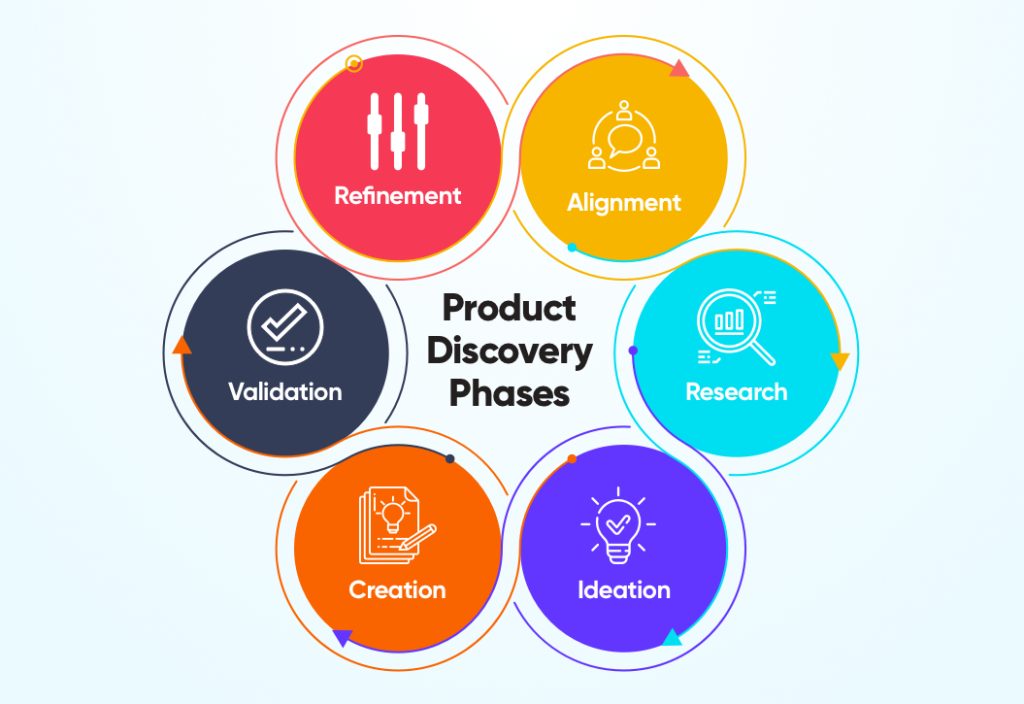
Phase 1: Aligning the Team
For making a successful product, it is essential to develop a shared understanding among the key stakeholders or decision-makers of the product team — that’s what Project Managers do in the first and initial phase of product discovery — Alignment.
Project Managers usually organize a start-up meeting which is also called a kickoff meeting. Though explicitly scheduled to discuss the need of the project and segregate what each one of the stakeholders knows about the product, it has the following agendas:
- Developing a common understanding of the problem
- Settling on the means or ways to accomplish the purpose
- Establishing trust between various stakeholders
Depending on the project complexity, the duration of the kickoff meeting can vary. While it can last just a few hours if the project has low or medium-complexity, it can even take days for too complex projects.
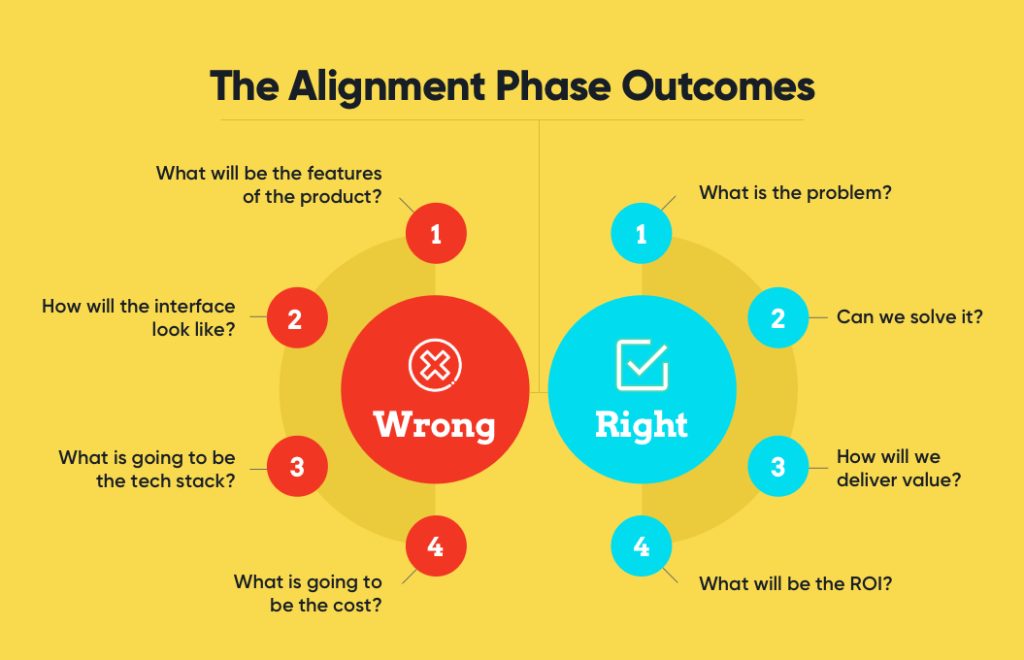
Because the Alignment phase includes many stakeholders, it is the Product Manager’s responsibility to keep product management aligned among all teams involved in the project. Instead of finding a feasible solution, stakeholders and managers should focus more on defining the real problems and understanding the users facing them.
Phase 2: Performing User Research
While in the Alignment phase, we discuss the problem statement in detail internally. The research phase involves going out and gathering data to test whether the assumptions we have are right, partially right, or wrong.
For user research, the software development company uses various tools and techniques to gather user feedback in an organized way, helping reveal the actual user needs. Depending on the product type, teams can conduct user interviews, observation studies, surveys, and competitor research to execute the research process.
Design artefacts created as a part of User Research step includes:
Empathy Maps
The empathy map is an easy-to-understand visual that captures users’ behavior, attitude and presents them on a four-quadrant diagram. It is a useful and reliable technique to help product teams understand their users.
Basically, the diagram reflects what users think, see, hear, and say that show their challenges, pain-points, and opportunities you need to focus on. It gives product teams a clear idea of what users think about the problem and their desired solutions.
Here’s what an empathy map should look like:
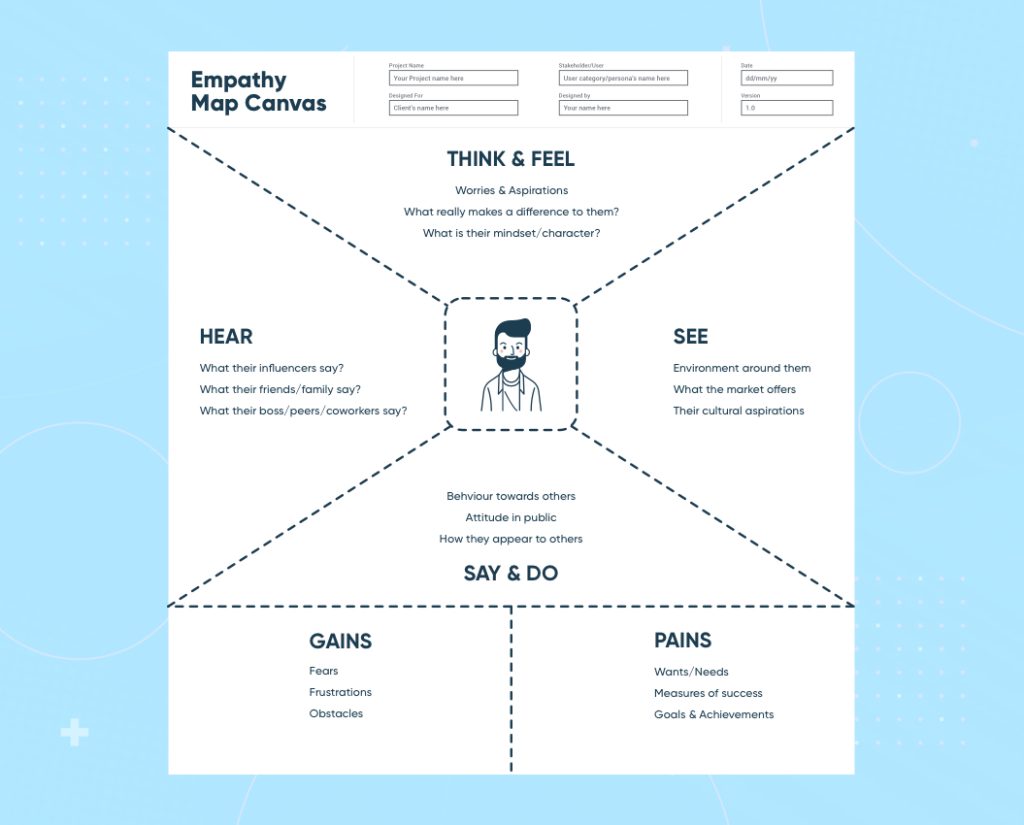
As the name suggests, empathy maps created for user research let us build empathy with the end-users. Based on real user data, they can uncover unknown user needs and lead us towards meaningful user research for product discovery.
User Personas
Knowing your target audience is one of the most crucial product discovery Steps that can be accomplished using user personas.
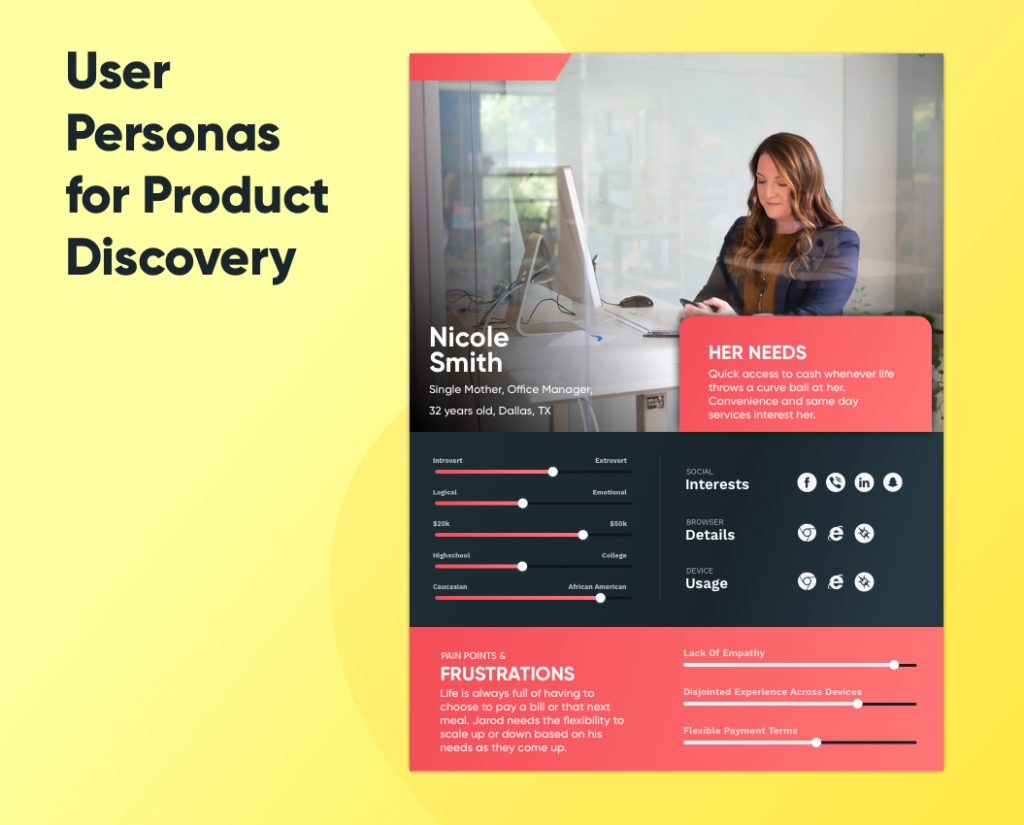
A user persona is a fictional representation of your target customer. It is usually based on user research, including your ideal customers’ goals, needs, demographics, and behavior. A user persona clarifies who is your target audience by answering the below-mentioned questions:
- Who am I going to target?
- What are their problems?
- What are their goals or needs?
Well-developed user personas are a fantastic way to research your target audience. These are helpful reminders of your product’s end goal — to serve the desires of real people. By knowing who your users are and what they want, you can develop products that truly delight them.
Interviews and Surveys
The well-known and widely used methods for conducting user research are surveys and interviews.
An interview is a method used to determine the potential customers’ beliefs, attitudes, and experiences. These are conducted by an interviewer talking one-to-one with a user for around 15-30 minutes or more. You can interview on the phone, online, or via video chat applications.
On the other hand, a survey is the cheapest method of conducting user research. It includes a set of questions that you ask your potential users to determine their attitudes, preferences, opinions, needs, and goals about a given topic. Generally, surveys are conducted online through forms. This method lets companies collect the required data quickly from several users and that too at a low-price.
While there are other methods as well for conducting user research like usability testing or running user groups, the three mentioned above are the most popular ones. Now, what user research method you use depends entirely on your overall research goals — whether you are finding a way to improve your existing product that is already in use or planning to build something to solve an unsolved problem.
For better understanding, the research is divided into four categories:
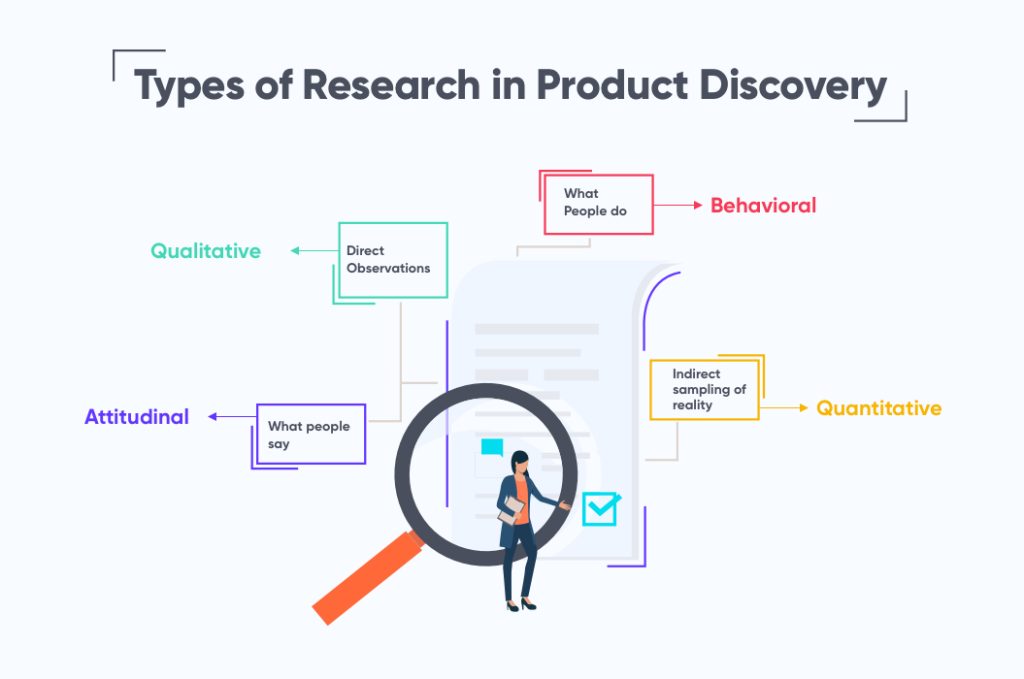
Attitudinal Research — used to understand or analyze the attitude of the user. For example, usability testing focuses on performance and actions.
Behavioral Research — used to understand the behavior of the users. For example, interviews and personas talk about how people think about the product.
Quantitative Research — collects the measurable data and gives you exact figures to analyze the situation. For example, what percentage of users added a particular item to their wish-list.
Qualitative Research — collects the reasons behind these actions. For example, what made them add an item to the wish-list.
While Qualitative research is useful for answering questions like why or how to fix a particular problem, quantitative research is excellent for finding how many and how much. You can also combine different methods of research to find whether there is a difference between what people say and what they actually do. The end goal should be to find the right information about who your users are and what they want.
Phase 3: Ideation
In this phase, you start moving towards the solution space. Now that you know your users’ problems, you can move forward to find ways to solve these problems.
Consider organizing a meeting with all the project stakeholders to present the data collected and solutions in-hand to solve the problem.
However, try not to throw everything you have collected to the team in one go. Present the data in chunks and give your stakeholders time to process the information and brainstorm around them. When ideas come from all sides, it is time to prioritize them and find a viable solution.
You can structure the entire ideation process for a better organization by placing the same ideas in a similar cluster. Your team member can then vote for their favorite idea, and the most-voted should be given priority.
At this stage, you should focus on what features will make your product more useful. Therefore, by the end of this phase, you must have your product’s vision and objectives crystal clear.
Prepare the first organized version of the collected information and start sketching the ideas.
Phase 4: Prototyping
It is time to develop several inexpensive and simple versions of your product with specific features. You can test these prototypes within the team or with a small group of people from outside.
Remember, this is just an experimentation stage, and we aren’t creating the actual end product here. The goal still is to find the best possible solution to the problems identified earlier.
You will have to implement solutions within the prototypes and test whether they are acceptable, need improvement, re-examining, or rejected based on their user experience. By the end of this stage, the design team will have a clear view of how a real user would interact, think, and feel when using the end product. Here are a few tips for better executing discovery prototyping:
Don’t try to develop hi-fidelity mockups: At this stage, you are just testing your solutions and validating your ideas. So it would be wise not to waste your efforts in creating hi-fidelity mockups until you have a clear solution architecture. Remember, you are trying to prototype an experience here, which is not always defined through a UI.
Prototyping is never a linear process: It is an iterative process. So, you can’t expect to find the right solution in one go. You will have to experiment and try several approaches before settling down with the one that works best for your business and users. The product discovery process in agile teams revolves around making plans, working on them, reviewing the progress, and learning from it to make it better and feasible.
Involve developers and stakeholders: The most common mistake product teams commit is not involving developers and stakeholders in the prototyping phase. Without developers, you can’t decide whether a specific design is feasible or not. It invites rework and significant refinements, which is a waste of time as well as money.
Phase 5: Validating the Ideas
During the idea validation stage, you finalize whether the product idea is worth spending your resources, time, and money. Though this phase relates a lot to the user research phase, at this point, you have a viable solution in your hands.
You must consider validating your ideas and solutions from different angles and using several methods for a better outcome. For example, you can use A/B testing, user interviews, and surveys to see how users would react to your product.
While using different approaches to validate your idea, make sure to stay true about the Signal Strength. It shows how reliable your results are and helps you make the right decision.
Phase 6: Refinement
As mentioned earlier, product discovery is not a linear process. For making a useful product, you need to move back and forth and align your users’ needs with your business goals.
What you do during this phase also depends on the outcomes of your idea validation stage. If you successfully validate your idea, you will gather data to build an MVP in this stage.
On the other hand, if your idea fails in the validation test, you may have to take steps back to the research phase to find what went wrong.
In the product development journey, the next step after this phase is going to be Product Delivery. Therefore, you must have a set of validated assumptions and ideas (ready to serve as an input for building and validating an MVP) before moving to the next stage.
Moreover, teams usually have the outcomes of all the above phases in an unorganized way. The primary task your product team requires to do at this stage is to organize the data as per your company’s processes and guidelines. For a better structure, break the validated ideas into clusters, prioritize them, and plan the development timelines.
4 Mistakes Committed in Product Discovery Process
Product development teams often see “discovery” as just a process and misunderstand its role. It requires a user-centered, data-driven, and continuously evolving mindset to build products that solve real-world problems.
Here are five of the most common mistakes that the product teams make (but you shouldn’t) when working on product discoveries:
1. Not Paying Attention to Real User Problems
“If I had an hour to solve a problem, I would spend the first 55 minutes determining the problem and could solve the problem in less than five minutes.” — Albert Einstein, Theoretical Physicist.
This quote from Albert Einstein reflects how crucial it is to frame the problem. However, product teams being so eager to launch the solution, overlook defining/knowing the user problems.
When product development teams don’t pay attention to user problems, they aren’t able to create real value for them and end up ruining the project. To ensure positive outcomes of your product development efforts, make sure you refine your understanding of the problem through several iterations.
2. Not Involving Developers in the Discovery Process
If you involve your developers just for coding in the product development process, it is a mistake.
Developers need to understand problems too. If your developers didn’t understand the problem, how would they solve it? Moreover, suppose the Product Manager doesn’t involve them in the discovery phase. In that case, PMs will be responsible for explaining the project’s nitty-gritty to developers, which may lead to a wrong understanding of the problem.
Remember, your developers can provide you valuable technical insights on how you can develop an essential feature by putting less effort. So, consider involving them throughout the discovery process.
3. Not Having the Right Mindset
As mentioned earlier, product discovery activities are all about focusing on the problem. Therefore, you must have the right mindset when approaching the process. It is all about:
- Studying market trends to understand user need
- Not being afraid of asking basic questions & testing assumptions
The product teams often think if they ask basic questions, they will look stupid. Or, it will look like they don’t understand the concept or don’t have a clear vision of the problem at hand. However, by asking the basic questions, you try to test your assumption (which is crucial) instead of challenging the problem.
4. Outsourcing & Not Getting Involved
An outsourcing company can surely help you with effective product discovery, but only if you stay involved in the process. Just grasping insights, data, and reports won’t help you decide the users’ real needs.
You need to make direct contact with the end-users, validate the ideas, and even help in prototyping to discover a useful product. Remember, successful outcomes are always the results of innovative and collaborative efforts.
Let’s now see some of the tools and techniques that can help you go through the product discovery process like a pro:
Product Discovery Tools and Techniques
Discovering the right product is crucial for your business and users. Also, many factors need to work out to deliver a successful outcome — an excellent idea, the right resources, investors, the right tools and techniques.
While nothing can guarantee the discovery of the right products, the below-mentioned tools and techniques can help you en-route:
Design Thinking
Design Thinking encourages organizations to make user-centric products by finding data about users’ needs and producing creative ideas to solve them.
It focuses on what is desirable from a human perspective, financially viable and technically feasible. That is the reason design thinking is an incredible tool for product discovery initiatives. It centers around the following stages:
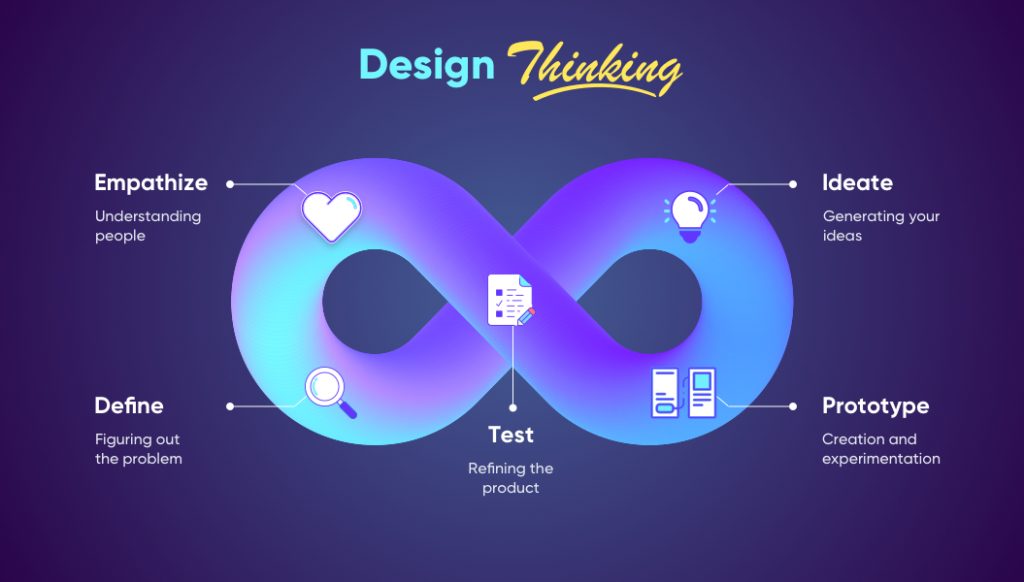
Empathy: This phase is about understanding the needs, desires, and problems of potential users. It is all about putting yourself in your customers’ shoes and making efforts to dive into the feelings of your customer base.
Define the Problems: In this phase of the design thinking, you take the entire data you have collected during the empathize phase and thoroughly analyze it to define the major issues you’ve noticed.
Remaining by the essence of design thinking, it’s always good to define problems in a user-centric manner instead of using a product-centric approach.
For instance, rather than saying we need to increase our website’s sales by 15%, you might say users should be able to find items on our website immediately, and it should be simple for them to complete their purchase.
Ideation: This stage is all about coming up with as many ideas as possible. The only condition is that they should be an answer to the problems specified in the earlier phases.
It can be an app feature you’ve been considering for a long time or an idea of a product that just came to your mind.
Prototype: Once you’ve got the ideas, select the best ones that solve the user’s problems and start prototyping. Making a prototype of the product makes it simple to test out the proposed solutions produced in the Ideation stage.
The motive behind making a prototype is to rejuvenate ideas and select the ideal solution to move forward. Tools like MockFlow and InVision are great for making quick prototypes.
Test: When you have a functional prototype, you can test its ease of use to check whether it solves the issues you found in the earlier stages. Though this is the last phase of the process, the usability issues found during this stage are usually used to redefine the problem and go back to a previous stage.
If the issue is extreme, you may need to go right back to the Empathize stage. Or, if it’s a minor issue and you’re able to define it precisely, you can go back to the Ideate stage instead.
Lean Canvas
The lean canvas is a makeover version of the business model canvas, which can help you in product discovery using the problem-solution approach. It enables you to understand your user’s needs, focus on the problems at hand, and deliver a rapid solution.
Here is what a lean business model canvas looks like:
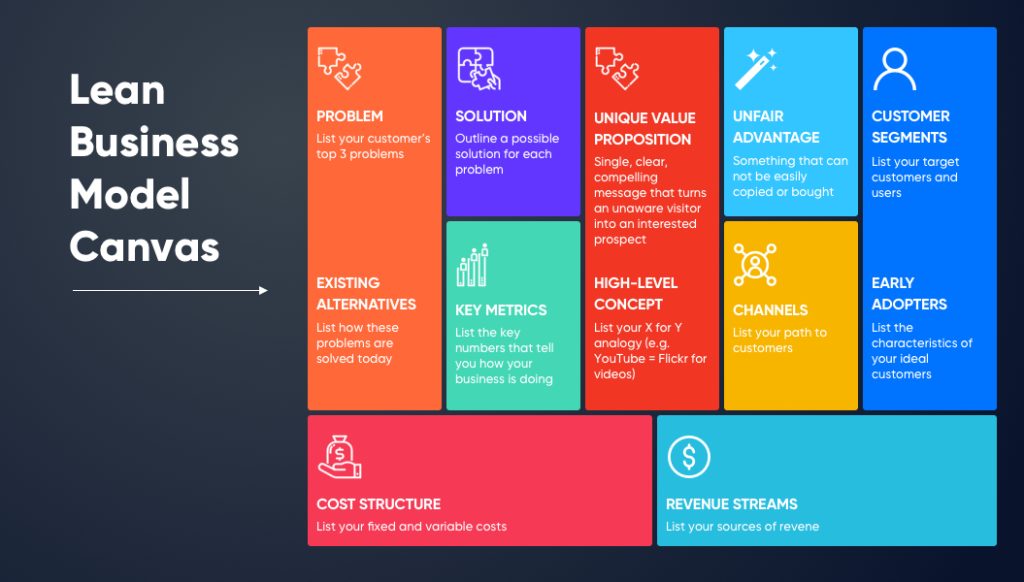
It gives a holistic view of your business and lets you see and analyze how different aspects influence each other. Through lean canvas, you will have a more in-depth look at the user’s problems and how your product can address them.
Let’s look at the nine elements that make up the Lean Canvas and analyze them having the idea of a vacation-rental app like Airbnb in mind:
Problem: In this section, you list the issues you are trying to solve. For example, it is hard for tourists to find affordable yet homely accommodation when traveling. On the other hand, it is not easy for homeowners to monetize their empty homes and generate profits.
Solution: What you add in this section should effectively solve the problem mentioned. In this case, the solution is an online service that acts as a platform where tourists can find homely accommodations and property owners can list their properties to monetize.
Unique Value Proposition: This statement should convey your product’s unique value to your user’s lives. For example, the product here provides a home away from home to tourists and creates monetization opportunities for property owners.
Customer Segment: This section shall list who your target audience is going to be. These could be travelers looking for cheap accommodation to explore the local culture or people having vacant homes who want to earn using their properties.
Unfair Advantage: This section specifies what additional advantages your product is going to provide. In the case of Airbnb like Startup, a bi-directional rating and review system to keep everything as transparent as possible or insurance for hosts, for example.
Revenue Streams: This is one of the main parts of the lean canvas. You must list your revenue sources here using which you are planning to bring money to the table. For example, a platform like Airbnb makes money by charging commissions.
Cost Structure: Here, you’ll add the expenses required for the proper functioning of the product. For example, development, marketing, salaries of employees, photography, insurance, and more.
Key Metrics: List how you will measure your product’s success and be very specific here — for example, the number of accommodations booked or the number of registered hosts in a day.
Channels: Define channels you will be using to talk to your customers — for example, a website, mobile app, social media channels, and more.
As a tool to use in the product discovery phase, Lean Canvas is just perfect. It lets you stay lean and is easy to build and adapt.
Just like the product discovery approach, Lean Canvas is not at all linear. It is meant to be crafted, revised, modified, and recreated from scratch by the agile discovery team trying to build the right product. In the same way as your initial assumptions or ideas change, so should the lean canvas content.
It is an excellent strategy to revise your lean canvas regularly and keep changing its content. It provides you a holistic view of what you are trying to build and the role of every party involved. Lean canvas will always help you bring up some fresh ideas and challenge your assumptions as you move forward in your product discovery and development phases.
Value Proposition Canvas
The Value Proposition Canvas is a digital tool that product teams can use to define how the product will solve customer’s pains. It lets you quickly create an alignment within a team and with all the parties involved in a project.
The VPC helps product teams access the present state of product discovery initiative and acts as a grammar that they can use to form value propositions.
Here is how the Value Proposition Canvas looks like:
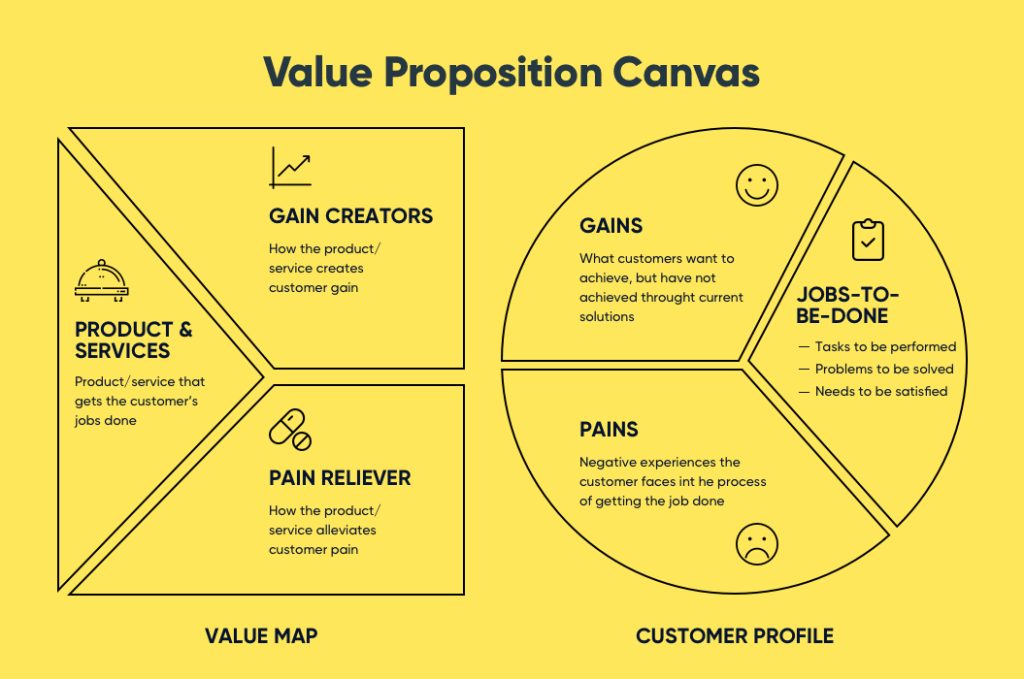
Here, the circle section is responsible for describing the customer profile – the job they must perform and positive and negative experiences associated with the same. The Value Proposition canvas helps you define and know your target audience from all the perspectives – emotional, functional, and social.
The square part lists the value you can create with your product or service, which is done by creating gain and relieving your customers’ pain.
The product team sometimes falls in love with the idea of their products, and it may create blind spots. The focus gets disturbed, and they may find themselves lost after a particular point. Another chance is that they might move in the wrong direction and go too far to create a low-demand product as the outcome. For avoiding such scenarios, the value proposition canvas acts as a fundamental guideline to stay on track and focused.
It let Product Managers understand the target audience, what they desire, and how to make them satisfied. Based on this data, businesses can shape the idea of what features and functionalities are crucial for the product to be in high demand.
Let’s check out Value Proposition Canvas created for Uber, a taxi booking app, for better understanding:
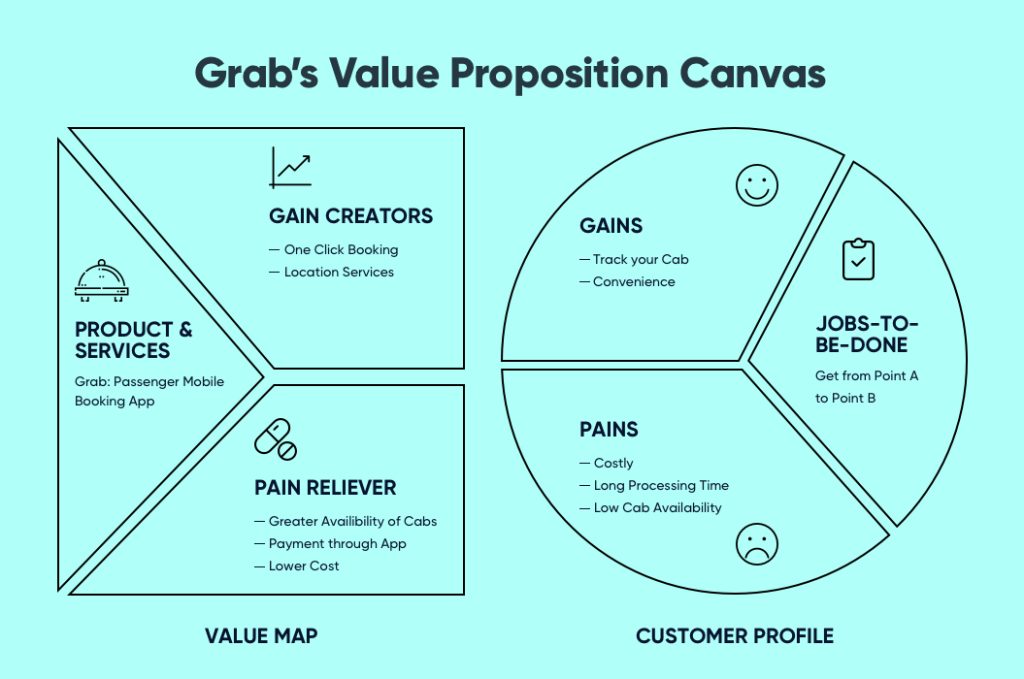
The above-mentioned product discovery techniques will prove useful for budding entrepreneurs as well as startups indulged in product development. If you are planning to discover a disruptive product, give them a shot and experience the effects.
How Net Solutions Helped a Leading FMCG Player in Product Discovery Using Design Thinking?
One of the leading FMCG players reached out to Net Solutions to update their existing mobile app.
Their mobile app aimed at empowering rural women by generating opportunities for them to sell products and earn a living. The ultimate goal of the client was to increase the adoption rate of the app by reducing friction in the existing user journey.
To reach the goal, he wanted us to integration the following features in the app:
- Integration with third-party suppliers
- Real-time stock updates
- Order placement
Initially, the client assumed that the integration of these features would be enough to achieve the desired goal. However, while researching on the project, the team at Net Solutions realized that unless we identify all the reasons behind friction in the user’s journey, just adding a few advanced features to the app will not solve the problem.
Then our team decided to go back to the product discovery phase to access the real user problems. Our UX team went to the rural areas the app served and interviewed both — the entrepreneurs as well as the company’s sales representatives. They conducted ethnographic research and found key challenges that end-users faced in the field.
We then applied the Design Thinking approach to understand the gaps in user journey. Our team spent around 24 hours with all the stakeholders to further identify their issues.
This research helped us build a new app with features designed and validated by the stakeholders who are ultimately going to be using it. Our efforts resulted in increased app adoption rate and a 40% increase in overall sales of the app.
Conclusion
The product teams spend most of their time in product development. And it makes sense. They get paid for the delivery. However, this approach often leads to the teams delivering the wrong products with features that are not at all useful.
This article lists everything teams need to know about product discovery and its process. If you follow a step-by-step approach to product discovery in an environment of continuous learning, it will benefit all – investors, product owners, developers, and the overall business.

